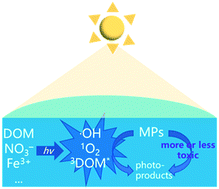Essential role of sunlight irradiation in aqueous micropollutant transformations: influence of the water matrix and changes in toxicities†
Abstract
Various micropollutants (MPs) that exist in surface water and treated wastewater have been continuously arousing concern because of their harmful ecological and health effects. Sunlight-induced photodegradation of MPs in water is a natural transformation pathway that has been critically reviewed in this work. According to observable photodegradation rates in ultrapure water, MPs were divided into fast, medium and slow groups where half-lives are less than 1 day, 1–10 days and more than 10 days, respectively. The phototransformation fates in diverse water matrices, including nitrate, iron, halides and inorganic ions, were summarized. In sunlit environmental water containing dissolved organic matter (DOM) and NO3−, MP photodegradation was likely accelerated. Iron, halides and inorganic ions show both acceleration and inhibition effects on MP photolysis. The main mechanism of phototransformation was revealed to involve radical species, mostly hydroxyl radicals, attacking MPs. For MP photoproducts, sunlight could increase or decrease the toxicity of the product compared to that of the parent MP. There is a risk that MP phototransformation products may still be toxic. Therefore, focusing on the integrated toxicity of solutions, including parent molecules and photoproducts, is more important in future study.

- This article is part of the themed collection: Environmental Science: Water Research & Technology Recent Review Articles


 Please wait while we load your content...
Please wait while we load your content...